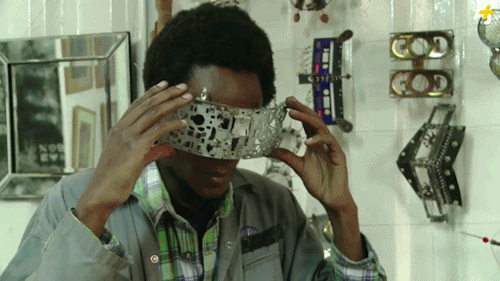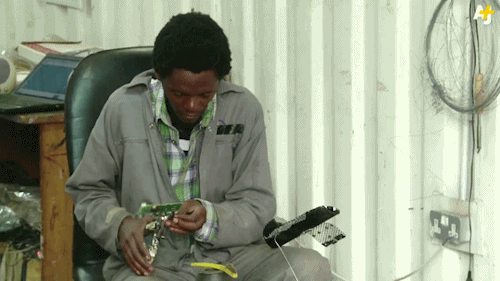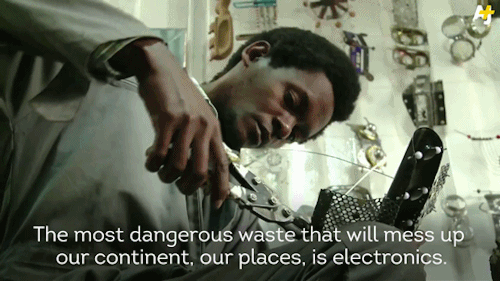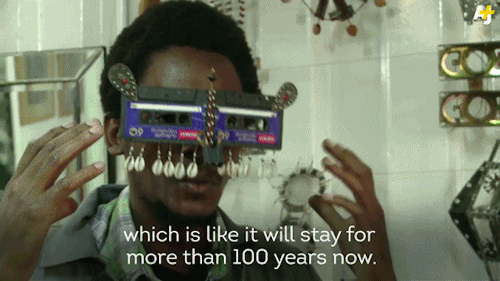Rama Thiaw Documente Les Engagements D'une Jeunesse Sénégalaise Entre Musique Et Politique.
Rama Thiaw documente les engagements d'une jeunesse sénégalaise entre musique et politique.
Réalisatrice et activiste, Rama Thiaw fait partie de la nouvelle génération de réalisateurs qui a choisi de bousculer les représentations médiatiques éculées sur l'Afrique. Son terrain de représentation c'est la ville branchée sur le monde, la musique et la politique et qui développe une culture urbaine faite de toutes les spécificités locales.
Nous avons rencontré Rama Thiaw à Dakar en décembre 2013. Au cours de cette première interview, elle évoque son itinéraire, des trottoirs de Pikine, dans la banlieue de Dakar, au choix du cinéma comme outil le plus adéquat pour lutter contre les stéréotypes. Son premier documentaire "Boul Fallé" sorti en 2009, revient sur les "nouvelles figures de la réussite" qui émergent au tournant des années 2000 alors que la jeunesse sénégalaise vit encore les effets de la dévaluation du franc CFA de 1994 et les programmes d'ajustements structurels imposés par le FMI. Le pouvoir contestataire du rap américain, le retour à la lutte sénégalaise jadis interdite par les colons, l'adoption d'une détermination plus individuelle à réussir vont être les symboles les plus médiatiques de cette jeunesse qui ne veut plus en référer qu'à elle même.
Son second documentaire "The Révolution won't be televised" devrait sortir cette année. Empruntant le pas au mouvement Y'EN A MARRE qui va aboutir au départ du Président Abdoulaye Wade en mai 2012, la réalisatrice dresse le portrait des deux protagonistes du groupe de rap Keur Gui2 Kaolack, Thiat et Kilifeu, initiateurs en 2011 du mouvement d'opposition au pouvoir le plus radical et le plus médiatisé de ces dernières années.
Dans ce second interview, Rama Thiaw fait le lien entre trois générations de jeunes qui ont à chaque fois affronté et déstabilisé le pouvoir en place : celle de mai 1968 avec la figure devenue mythique de Oumar Blondin Diop, celle des années blanches des années 1990 qui donnera ses lettres de noblesse au rap et enfin la génération Y EN A MARRE qui émerge dans la foulée des printemps arabes. Elle revient également sur la place de la musique qui n'est pas seulement un divertissement mais s'inscrit dans une tradition ancienne de lien entre les différentes composantes de la société sénégalaise.
Oulimata Gueye
More Posts from Associationxamxam and Others
Lu dans Oruun : Vitshois, un artiste épris de “librisme”...
oruun

Vitshois Mwilambwe Bondo est sans doute un des artistes congolais contemporains qui va marquer sa génération. Ayant développé une technique de collage à partir d'images récoltées dans les magazines de mode, cet artiste travaille sur le message d'un monde globalisé et dans le même temps chaotique d'où peut sortir quelque chose d'inédit. Sa notion de contemporanéité se rapporte ainsi à une idée de création résultant de rencontres, de chocs et de brassage des cultures. Héritier de la philosophie du librisme, Vitshois questionne de manière quasi permanente la place de l'art congolais sur l'échiquier du marché de l'art contemporain international. C'est donc dans une volonté d'échapper aux frontières géographiques et culturelles qu'il a créé sa propre structure à Kinshasa. Il propose à des jeunes artistes congolais sortis de l'académie des Beaux-Arts un lieu où ils peuvent venir expérimenter, échanger, apprendre et développer à travers leur travail une identité artistique propre. Une identité libérée de tout carcan et autres cases dans lesquelles, malheureusement, on essaie souvent de les confiner.
la suite ...

David Hammons, Untitled (The Embrace), 1975
(A riff on Klimt’s Kiss? or are we hallucinating…)

via adacreate 11 May 2014 - 12 May 2014 / “Global Black Consciousness” Hôtel Sokhamon, Dakar, Senegal
The Institute for Comparative Modernities (Cornell University) and the Institute of African American Affairs (New York University) will hold the international conference “Global Black Consciousness” on May 11 and 12, 2014, in Dakar, Senegal. The conference is coordinated by Margo Natalie Crawford and Salah Hassan (Cornell University) and Manthia Diawara (NYU). The conference will coincide with the opening days of the Dakar Biennale (Dak’Art 2014), which opens on May 9, 2014. The two-day gathering will focus on the theme of “Global Black Consciousness,” with invited participants who will present new and unpublished work.
THEME/CONCEPT:
Now that we have such tremendous scholarship on particular identities shaped by the African diaspora (Afro-German, Black British, African American, Afro-Latina/o, Afro-Caribbean, and many more) and tremendous theories of the value and limits of Pan-Africanism, Afro-pessimism, and many other “isms,” how do we create a space for the critical and nuanced analysis of global black consciousness as both a citing of diasporic flows and a grounded site of decolonizing movement? This multi-event and multi-site conference aims to explore the confluence between theories of diaspora and theories of decolonization. Moreover, the crisscrossing of visual art, literature, film, and other cultural productions will be explored alongside the crosscurrent that shaped the transnational flow of black consciousness. The scholars participating in this conference will situate their work in the space of the crisscrossing that occurred as the Black freedom struggle became a layering of locations and dislocations and past, present, and future.
The 1960s and 70s will be the pivot point as we think about the precursors and legacies of the 1960s and 70s black freedom struggles. From May 9 to June 8, 2014, Dak’Art, la Biennale de l’Art Africain Contemporain, will be held in Dakar. The theme and the occasion allow to revisit major Black and Pan-African intellectual movements and festivals (such as the Dakar’s Festival of World Negro Arts of 1966, Algiers of 1969, and FESTAC 1977 in Lagos, Nigeria, among others) in addition to revisiting individual artistic and intellectual work tied to Africa and the African Diaspora.
The conference’s papers will be published in a co-edited volume entitled Global Black Consciousness.










Collages by: Jamilla Okubo
Shot and Directed by Sir Dex R. Jones
Garment Designs/Headpieces: Jamilla Okubo
Pattern Designs on Fabric: Jamilla Okubo
Model: Jamilla Okubo
This was a project for my final assignment, for my “Fashion, Illustration, & Performance” class at Parsons.. which could potentially become the start of my thesis for this year. The design process of these garments all started with two collages that I created with patterns that I made, then I decided to bring them to life by creating them into garments and wearing them myself.
-jamilla okubo




Making Wearables From E-Waste
Video short from AJ+ interviews Nairobi artist Cyrus Kabiru who creates wearable art from electronic waste:
Meet Cyrus Kabiru. The Nairobi, Kenya artist is turning e-waste into wearables and art.
Cyrus also has a Tumblr blog [cyruskabiruart] which you can find here

Funsho Ogundipe Musician/Composer/Founder of Ayetoro, Lagos @101Ayetoro
Amadou Balake - “Super Bar Konon Mousso”
This tune by Amadou Balake the Burkinabe born vocalist was recorded in Lagos in 1978 at a time when Afrobeat had become one of the main vehicles for artistic expression by talented musicians on the African continent. Its groove and swing make it irresistible.








Space Age Buildings of Africa
Throughout the world, the 1950’s Space Age was known for its beautiful, bold architecture,full of swooshy curves and spaceship-shaped buildings. But some of the most vibrant and retro-futuristic buildings of the Space Age can be found in Africa. Here are the most amazing architectural achievements from Space-Age Africa. By Vince Miklos.
Mausoleum of Agostinho Neto, the first president of independent Angola in Luanda, Angola
Building in Warri, Nigeria
Kariakoo Market in Dar es Salaam, Tanzania
Memorial to the Martyrs in Ouagadougou, the capital city of Burkina Faso
Bujumbura International Airport, Bujumbura, Burundi
The CNPS building (The National Social Insurance Fund):
St. Paul’s Cathedral in Abidjan, Côte d’Ivoire (Ivory Coast), designed by Aldo Spirito, consecrated in 1980
The National Assembly, the parliament of Cameroon
See more here
Website / Facebook / Twitter / Instagram
Dedicated to the Cultural Preservation of the African Aesthetic
yes
-
 legreffon liked this · 10 years ago
legreffon liked this · 10 years ago -
 associationxamxam reblogged this · 10 years ago
associationxamxam reblogged this · 10 years ago

"Of whom and of what are we contemporaries? And, first and foremost, what does it mean to be contemporary?" Giorgio Agamben, Qu’est-ce que le contemporain?, Paris, Rivages, 2008. Photo: Icarus 13, Kiluanji Kia Henda
201 posts

